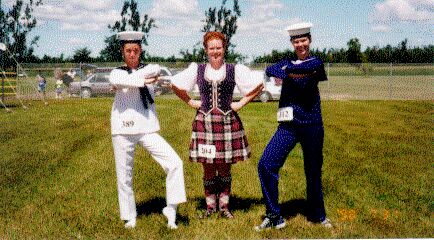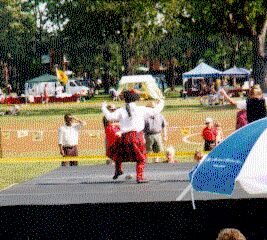Would you like to make this site your homepage? It's fast and easy...
Yes, Please make this my home page!


This page will give you the history of all the
highland dances. There are many dance that are done and each has its
own history and reasons for the way each dance looks.
The dances are the traditional ones Fling, Sword, and the national
dances like the Floria Macdonald, Lilt, Wilt thou go to thee Barracks...Johnny!!, and many more!

Highland Dancing is nothing like Irish Dancing!!!
Highland Dancing the dancers have turn out like ballet danciers
whereas Irish dancers do not. The other differents are that highland
dancers use their arms, Irish dancers have their arm straight beside
them.
We will start with the Fling one of the most
common dances.
FLING
It is victory dance usually preformed after a
victorious battle.It was danced by the warriors over a round sheild
called "Targe". Many Targes had a sharp spike in the centre, dancers
learnt fast to dance on the spot.
The dance is said to represent the Stag (Deer) on the hillside: The
fingers are grouped together and arms raised to represent the antlers
of the stag. It is a victory dance usually preformed after a
victorious battle.



This is a little boy doing a sword (left).
My friend Laruen doing a sword (right). This was at the Montreal
Highland Games summer '98.
Seann Triubhas
It is pronounced "Shawn Trews". Seann Triubhas is Gaelic for
"Old Trousers".
This dance came about from the rebellion in 1745 when Prince Charles
challenged England at Cullode, where he lost; and highlanders were not
allowed to wear their kilts. After, the Proscription Repeal which gave
the Scot their right to wear their kilts and play the bagpipes once
again.
The seann triubhas is the dance of joy in response to the Repeal in
1782.
The movements especially in the first stepare confined and sharp
representing the restrictions of the trousers. The following steps
are more flowing which shows the freedom of their kilts.
The next type of of dance is called a Reel. It is a dance which is
performed in a group.
REEL
There are three types of reels. There is a
Strathspey and Highland reel, Strathspey and Half Tulloch and there
is Stathspey and full Tulloch.
These dances are danced in a group of four. There is a slow part and
a quick part to every dance. The slow part is called a Stathspey
movement where the dancers move around each other in a figure of
eight and once back to their original postion do a setting step or
Stationary step, usually one of the fling steps are done. This is
done twice with two different setting steps.
The tempo of the music changes which dancers call quick time. the
quick time is a reel. During reel or quick time dancers move around
each other in a figure eight at a quicker pace, and again once in the
origional postion do a setting step, another figure eight is performed
and the last setting step all dancers do the same step in competition.
This is a comparison between the Highland
dress for men and women and what they also have in common.
Highland Dress
Mens Dress
 Sporran
Sporran
 Jacket
Jacket
 Bonnet
Bonnet
 Sgian Dhubl(the knife in the sock)
Sgian Dhubl(the knife in the sock)
Womens Dress
 Vest or Jacket
Vest or Jacket
 Silver or Gold edging on jacket or vest
Silver or Gold edging on jacket or vest
 Silver or Gold Buttons
Silver or Gold Buttons
 White shirt with lace at neck
White shirt with lace at neck
Both
 Standard Tartan kilt
Standard Tartan kilt
 Matching socks
Matching socks
 Black Gillies(dancing shoes)
Black Gillies(dancing shoes)
OTHER HOT LINKS TO MORE INFO







 Sporran
Sporran Jacket
Jacket Bonnet
Bonnet Sgian Dhubl(the knife in the sock)
Sgian Dhubl(the knife in the sock) Vest or Jacket
Vest or Jacket Silver or Gold edging on jacket or vest
Silver or Gold edging on jacket or vest Silver or Gold Buttons
Silver or Gold Buttons White shirt with lace at neck
White shirt with lace at neck Standard Tartan kilt
Standard Tartan kilt Matching socks
Matching socks Black Gillies(dancing shoes)
Black Gillies(dancing shoes)